
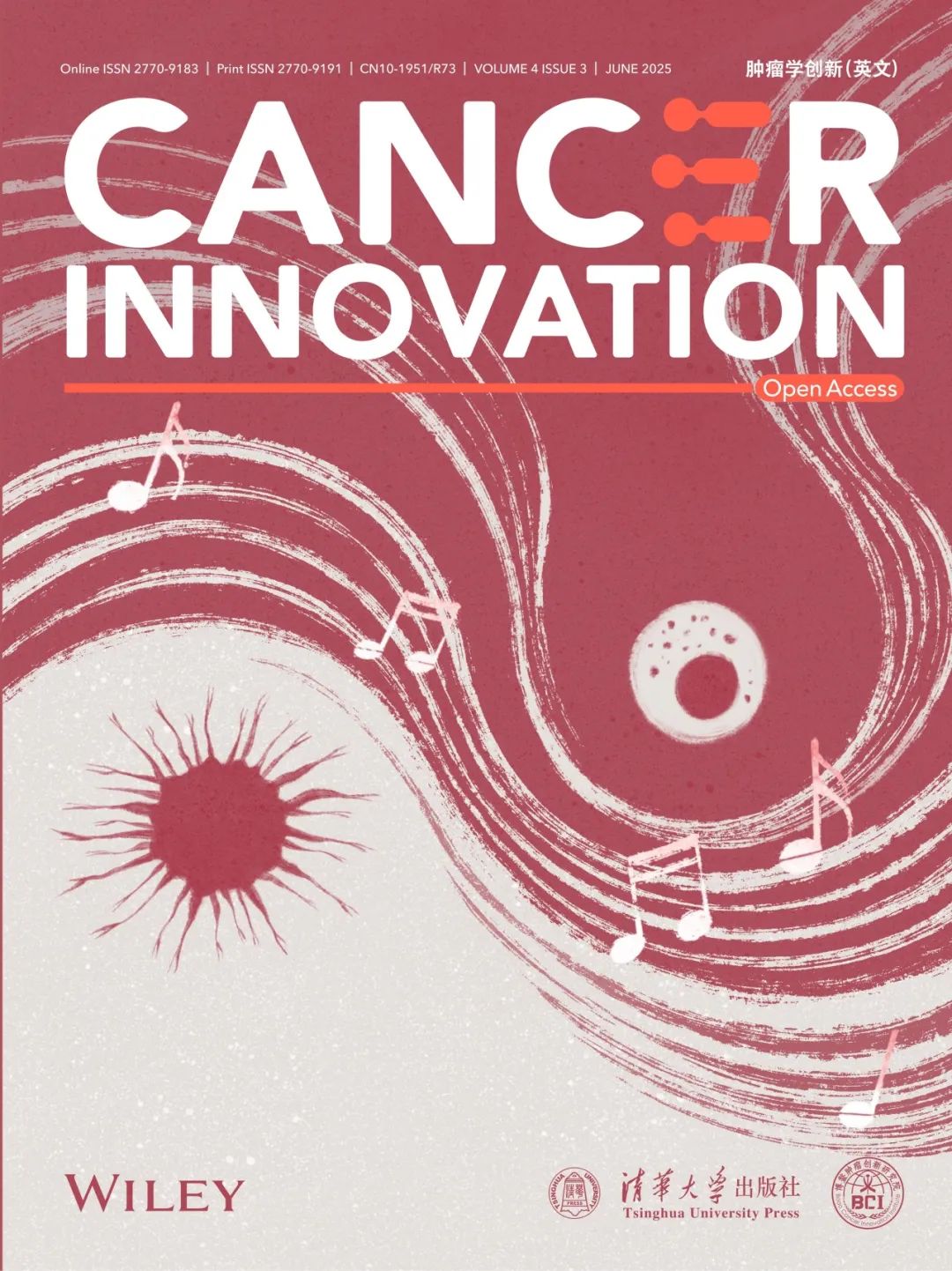
▸Cancer Innovation《肿瘤学创新(英文)》是由教育部主管,清华大学主办,清华大学出版社与 Wiley战略合作下出版的一本跨学科的开放获取(OA)英文期刊。
▸Cancer Innovation 是一本聚焦于肿瘤医学前沿的英文期刊,致力于促进医学与工学、信息学、药学、生物学等多学科交叉,引导肿瘤专业与心血管、呼吸、神经、生殖等跨专业融合。
▸Cancer Innovation 已入选“2022年中国科技期刊卓越行动计划高起点新刊项目”,已被国际知名数据库ESCI、PMC、Scopus、DOAJ、CAS(美国化学文摘)收录。
▸Cancer Innovation 名誉主编由中国工程院院士、国家癌症中心/中国医学科学院肿瘤医院国家新药(抗肿瘤)临床研究中心主任徐兵河院士,中国工程院院士、北京大学国际癌症研究院院长、北京大学健康医疗大数据国家研究院院长詹启敏院士,以及中国工程院院士、中科院上海药物研究所丁健院士共同担任,主编由国家癌症中心/中国医学科学院肿瘤医院马飞教授担任。
▸期刊发表论文类型多元,包括Original Article, Review, Clinical Guideline, Technical Report, Case Report, Commentary, News, Study Protocol, Meta-Analysis, Letter与Editorial。

(识别二维码即可免费阅读、下载本期所有文章)
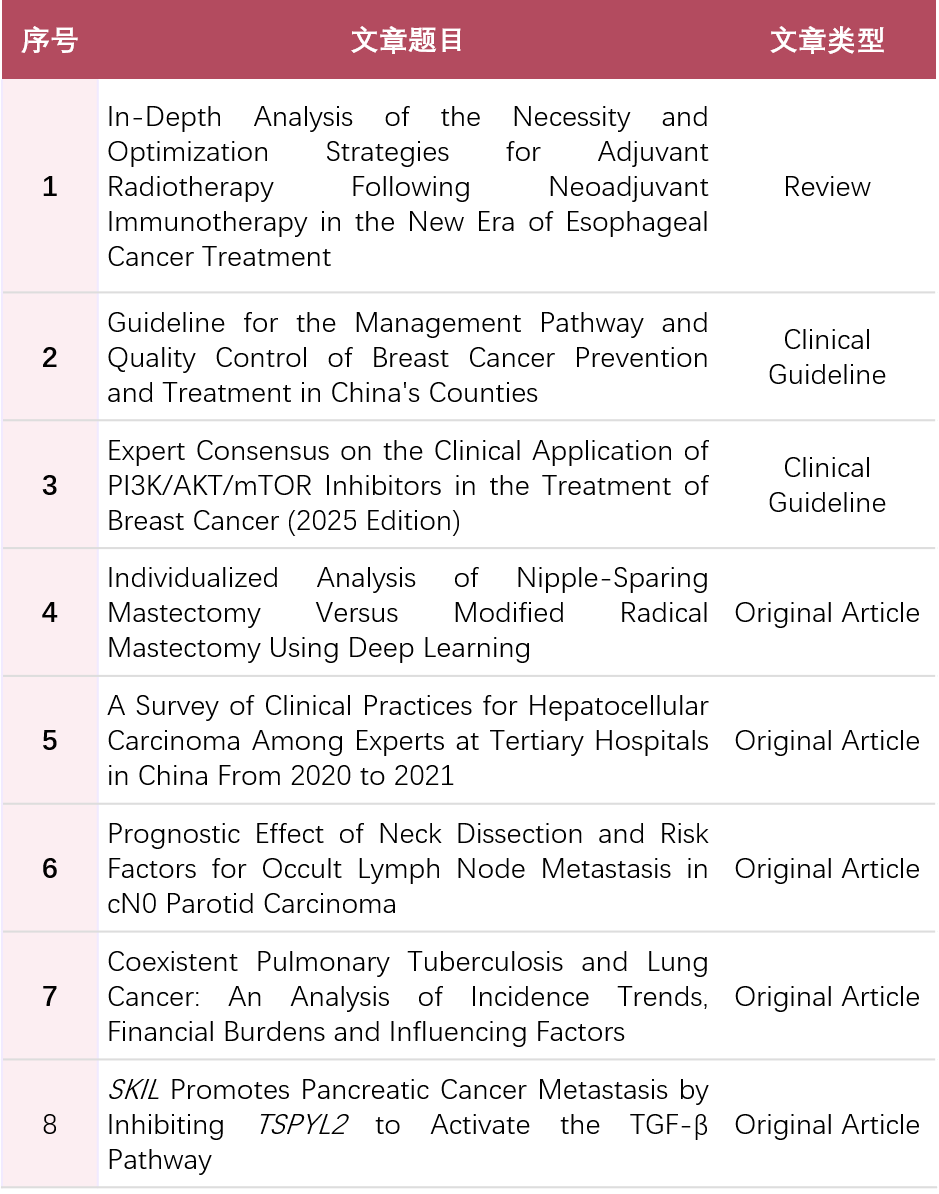
第4卷第3期(2025.6)
(▼ 点击图片免费阅读、下载全文)
注:本文中*表示通讯作者。

REVIEW

01
标题
In-Depth Analysis of the Necessity and Optimization Strategies for Adjuvant Radiotherapy Following Neoadjuvant Immunotherapy in the New Era of Esophageal Cancer Treatment
深入分析食管癌新辅助免疫治疗后辅助放疗的必要性及优化策略
作者
Guohui Liu, Yao Su, Yunlong He, Hanqing Hu*
图片摘要
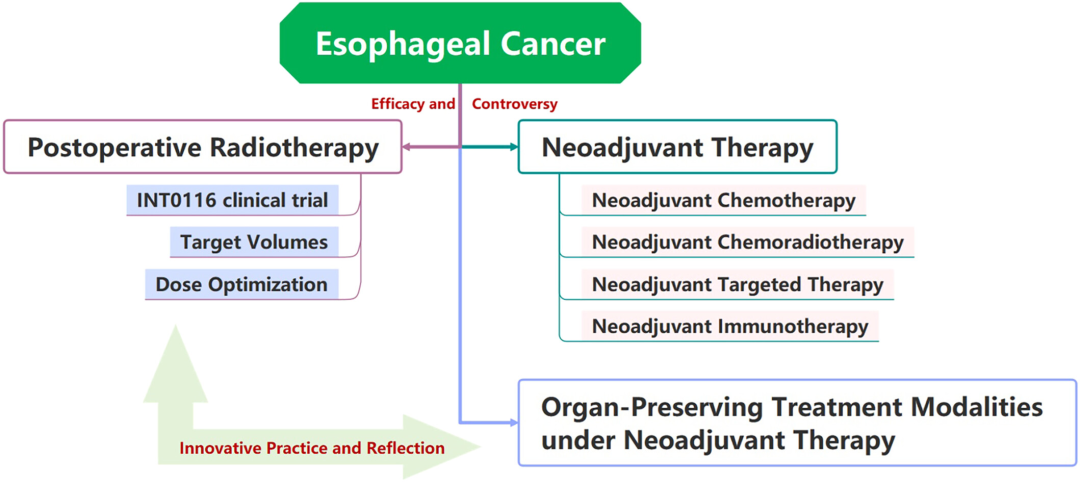
(点击图片即可免费阅读、下载全文)
As immunotherapy rises to prominence in cancer treatment, the therapeutic approach to esophageal cancer is undergoing significant transformations. This review emphasizes the necessity and optimization pathways for adjuvant postoperative radiotherapy after neoadjuvant therapy in patients with esophageal cancer in the immunotherapy era. Initially, we review the advancements in neoadjuvant treatment strategies. Subsequently, we evaluate the role of postoperative radiotherapy and the latest advancements in radiotherapy target volume definition and dose optimization following neoadjuvant therapy, as well as the implications of tumor immunotherapy on postoperative radiotherapy strategies. In conclusion, in the new era of immunotherapy, postoperative radiotherapy following neoadjuvant therapy for esophageal cancer holds significant value. Optimization strategies should follow individualized treatment principles and comprehensively consider tumor biology, patient status, and treatment resources to achieve optimal therapeutic outcomes and quality of life, thereby driving continuous innovation in esophageal cancer treatment.
如何引用
Liu, G., Su, Y., He, Y. and Hu, H. (2025), In-Depth Analysis of the Necessity and Optimization Strategies for Adjuvant Radiotherapy Following Neoadjuvant Immunotherapy in the New Era of Esophageal Cancer Treatment. Cancer Innovation, 4: e70010. https://doi.org/10.1002/cai2.70010

CLINICAL GUIDELINE

02
标题
Guideline for the Management Pathway and Quality Control of Breast Cancer Prevention and Treatment in China s Counties
中国县域乳腺癌防治管理路径与质量控制指南
作者
Breast Cancer Expert Committee of National Cancer Quality Control Center , Cancer Prevention and Treatment Committee of Healthy China Research Center
图片摘要

(点击图片即可免费阅读、下载全文)
Breast cancer is one of the most common malignant tumors among women in China, with approximately 306,000 new cases reported in 2016. Notably, around 33% (100,400) of these cases occurred in rural areas. County-level hospitals, encompassing counties and county-level cities, serve as the primary diagnostic units for the majority of rural breast cancer patients. These hospitals are integral to cancer prevention, screening, maintenance treatment, rehabilitation, follow-up, and referral processes. However, economic and geographical constraints result in county-level hospitals being relatively deficient in medical equipment, health human resources, and drug accessibility. Consequently, there is a critical need for breast cancer prevention and management guidelines that are tailored to the specific conditions of China s counties. In response to this need, and within the policy framework of hierarchical diagnosis and treatment, a Chinese expert group has developed the Guideline for the Management Pathway and Quality Control of Breast Cancer Prevention and Treatment in China s Counties (2023 Edition). This guideline aims to expand the availability of quality medical resources, ensure better distribution of these resources across regions, and enhance the capacity for breast cancer prevention and treatment. Ultimately, the goal is to improve the prognosis and quality of life for breast cancer patients in China s counties. This guideline includes clear and concise path diagrams that are easy to implement in clinical practice, serving as a valuable reference for clinicians in county-level hospitals.
如何引用
Breast Cancer Expert Committee of National Cancer Quality Control Center, & Cancer Prevention and Treatment Committee of Healthy China Research Center (2025). Guideline for the Management Pathway and Quality Control of Breast Cancer Prevention and Treatment in China s Counties. Cancer innovation, 4(3), e70005. https://doi.org/10.1002/cai2.70005
03
标题
Expert Consensus on the Clinical Application of PI3K/AKT/mTOR Inhibitors in the Treatment of Breast Cancer (2025 Edition)
PI3K/AKT/mTOR抑制剂治疗乳腺癌临床应用专家共识(2025版)
作者
The Breast Cancer Expert Committee of the National Quality Control Center for Cancer , The Expert Committee on Cancer Prevention and Treatment of the Health China Research Center , The Society of Clinical Research on Oncology Medications of the China Anti-Cancer Association , The Society of Onco-Pathology of the China Anti-Cancer Association
图片摘要

(识别二维码即可免费阅读、下载全文)
Background
The phosphoinositide 3-kinase (PI3K)/protein kinase B (PKB or AKT)/mammalian target of rapamycin (mTOR) signaling pathway (PAM pathway) plays a critical role in breast cancer pathogenesis and progression, and is closely linked with resistance to endocrine therapy in advanced breast cancer. Randomized clinical trials have shown that PI3K/AKT/mTOR inhibitors deliver significant clinical benefits, particularly for patients with advanced hormone receptor (HR)-positive, human epidermal growth factor receptor 2 (HER2)-negative breast cancer.
Methods
In 2022, the Breast Cancer Expert Committee of the National Cancer Quality Control Center convened specialists in related fields to draft the “Expert Consensus on the Clinical Application of PI3K/AKT/mTOR Inhibitors in the Treatment of Advanced Breast Cancer.” This consensus raised awareness of these inhibitors among oncologists in China and improved the precision of clinical decision-making. In recent years, growing evidence has emphasized the importance of targeting the PAM pathway, reflected in the approval of several innovative agents. This consensus is an updated 2025 edition that retains the foundational structure of the 2022 edition while incorporating notable updates.
Results
Updates to the consensus include the introduction of newly approved PAM pathway inhibitors, updated data from recent clinical trials, and expanded therapeutic applications. The revised guidance also offers updated recommendations for genetic testing to detect alterations in relevant pathways. The section on managing drug-related adverse events has been significantly expanded, providing detailed insights into different types of adverse events and their management. These updates aim to enhance the clinical application of PAM pathway inhibitors, promote precision medicine, and ultimately, improve survival outcomes for patients with breast cancer.
如何引用
Breast Cancer Expert Committee of the National Quality Control Center for Cancer, Expert Committee on Cancer Prevention and Treatment of the Health China Research Center, Society of Clinical Research on Oncology Medications of the China Anti‐Cancer Association, & Society of Onco‐Pathology of the China Anti‐Cancer Association (2025). Expert Consensus on the Clinical Application of PI3K/AKT/mTOR Inhibitors in the Treatment of Breast Cancer (2025 Edition). Cancer innovation, 4(3), e70008. https://doi.org/10.1002/cai2.70008

ORIGINAL ARTICLE

04
标题
Individualized Analysis of Nipple-Sparing Mastectomy Versus Modified Radical Mastectomy Using Deep Learning
基于深度学习的乳腺手术个体化决策:乳头保留乳腺切除术与改良根治性乳腺切除术的比较研究
作者
Enzhao Zhu, Linmei Zhang, Pu Ai, Jiayi Wang, Chunyu Hu, Huiqing Pan, Weizhong Shi, Ziqin Xu, Yidan Fang, Zisheng Ai*
图片摘要
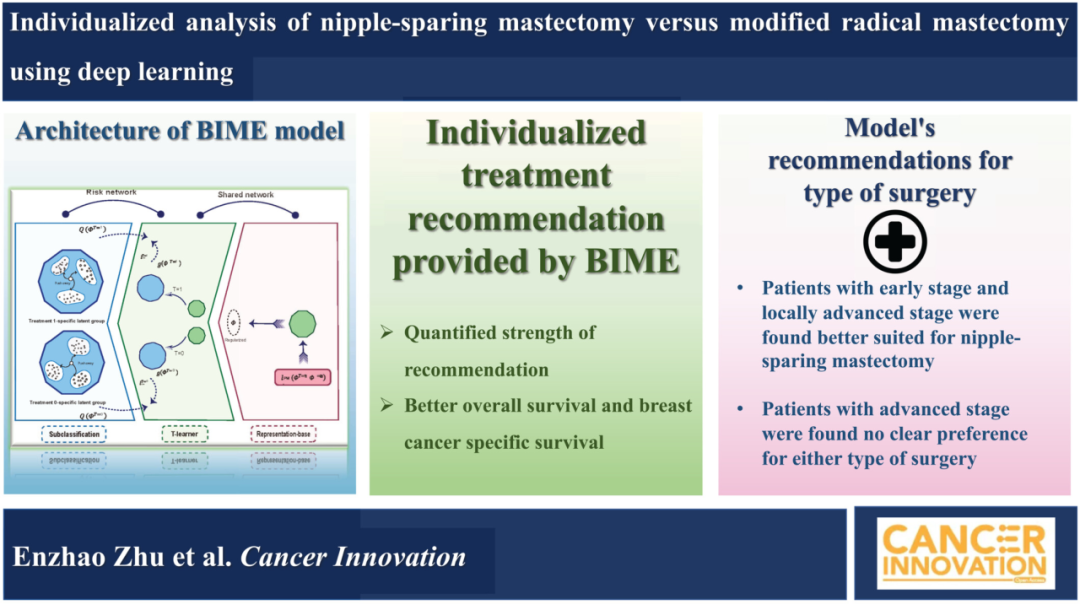
(点击图片即可免费阅读、下载全文)
Background
This study aimed to evaluate the impact of nipple-sparing mastectomy (NSM) and modified radical mastectomy (MRM) on individual survival outcomes and to assess the potential of neoadjuvant systemic therapy (NST) in reducing surgical intervention requirements.
Methods
To develop treatment recommendations for breast cancer patients, five machine learning models were trained. To mitigate bias in treatment allocation, advanced statistical methods, including propensity score matching (PSM) and inverse probability treatment weighting (IPTW), were applied.
Results
NSM demonstrated either superior or noninferior survival outcomes compared with MRM across all breast cancer stages, irrespective of adjustments for IPTW and PSM. Among all models and National Comprehensive Cancer Network guidelines, the Balanced Individual and Mixture Effect (BIME) for survival regression model proposed in this study showed the strongest protective effects in treatment recommendations, as evidenced by an IPTW hazard ratio of 0.39 (95% CI: 0.26–0.59), an IPTW risk difference of 19.66% (95% CI: 18.20–21.13), and an IPTW difference in restricted mean survival time of 17.77 months (95% CI: 16.37–19.21). NST independently reduced the probability of surgical intervention by 1.4% (95% CI: 0.9%–2.0%), with the greatest impact observed in patients with locally advanced breast cancer, in whom a 4.5% reduction (95% CI: 3.8%–5.2%) in surgical selection was noted.
Conclusions
The BIME model provides superior accuracy in recommending surgical approaches for breast cancer patients, leading to improved survival outcomes. These findings underscore the potential of BIME to enhance clinical decision-making. However, further investigation incorporating comprehensive prognostic evaluation is needed to optimize the surgical selection process and refine its clinical utility.
如何引用
Zhu, E., Zhang, L., Ai, P., Wang, J., Hu, C., Pan, H., Shi, W., Xu, Z., Fang, Y. and Ai, Z. (2025), Individualized Analysis of Nipple-Sparing Mastectomy Versus Modified Radical Mastectomy Using Deep Learning. Cancer Innovation, 4: e70002. https://doi.org/10.1002/cai2.70002
05
标题
A Survey of Clinical Practices for Hepatocellular Carcinoma Among Experts at Tertiary Hospitals in China From 2020 to 2021
2020 - 2021年中国三级医院肝癌专家临床实践调查研究
作者
Hong Zhao, Yilei Mao, Hongguang Wang, Aiping Zhou, Zhengqiang Yang, Yue Han, Gong Li, Xinyu Bi, Chunyi Hao, Xiaodong Wang, Jun Zhou, Chaoliu Dai, Feng Wen, Jingdong Zhang, Ruibao Liu, Tao Li, Lei Zhao, Zuoxing Niu, Tianfu Wen, Qiu Li, Hongmei Zhang, Xiaoming Chen, Minshan Chen, Ming Zhao, Yajin Chen, Jun Yu, Jie Shen, Xiangchen Li, Lianxin Liu, Zhiyong Huang, Wei Zhang, Feng Shen, Weiping Zhou, Zhengang Yuan, Jian Zhai, Ningling Ge, Yongjun Chen, Huichuan Sun, Jianqiang Cai*
图片摘要
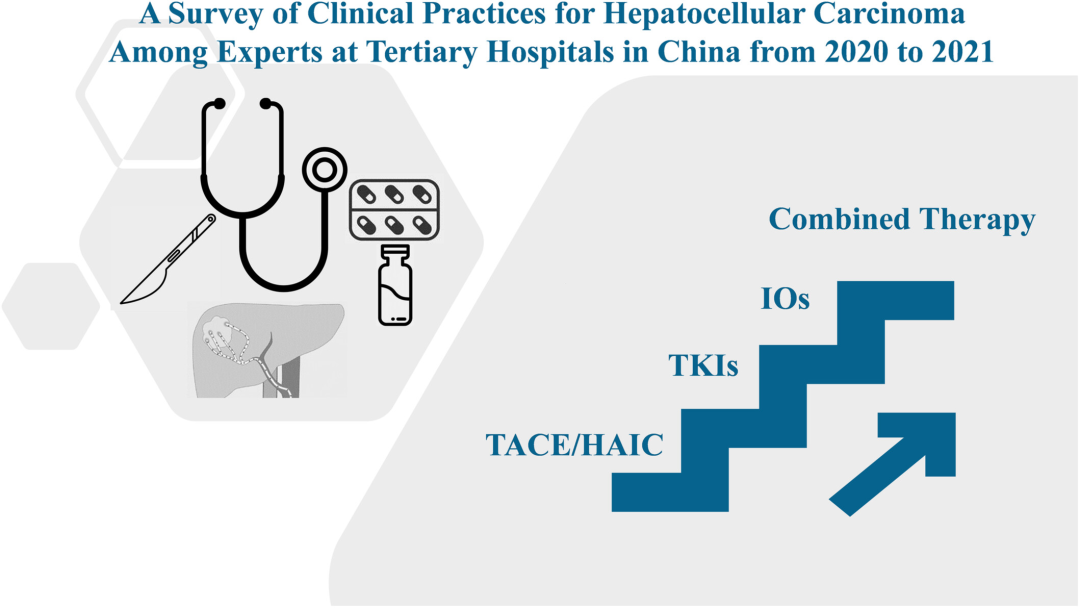
(点击图片即可免费阅读、下载全文)
Background
Hepatocellular carcinoma (HCC) is the second leading cause of cancer-related death in China. The rapid progress in systemic therapies has led to the approval of many therapeutic methods that have quickly changed clinical guidelines and practices. Because of the high heterogeneity of HCC, there are still some gaps between the guidelines and real-world clinical practice. The present study surveyed experts in China to investigate the current treatment concepts and clinical practice regarding HCC.
Methods
A questionnaire survey on the treatment concepts and clinical practice of HCC was administered to 310 experts with senior professional titles in 2020 and 312 experts in 2021. The results were analyzed and compared.
Results
For treating patients with resectable HCC, 28% of hepatobiliary surgeons indicated neoadjuvant therapy, and 7% chose systemic therapy ± locoregional therapy as 1 L therapy in 2021 compared with 20% and 1% in 2020. More experts chose adjuvant treatment within 1 month in 2021 compared with 2020, and 6 months and 12 months were the leading choices for the duration of adjuvant treatment. In 2021, 79% of surgeons and 19% of interventionalists were willing to conduct downstaging/conversion therapy for patients with potentially resectable HCC, and 78% chose tyrosine kinase inhibitors (TKI) + immunotherapy (IO) + locoregional therapy for cases in which R0 resection could not be achieved. For completely unresectable HCC, more experts preferred TKI + IO-based therapy as 1 L therapy in 2021 compared with 2020 (78% vs. 55%). The proportion of experts who indicated TKI + IO-based therapy as 2 L therapy increased from 32% in 2020 to 40% in 2021.
Conclusion
The survey results indicated that in 2021, compared with 2020, more experts opted to administer IO + TKI for the treatment of liver cancer, and more experts and patients were willing to participate in clinical research.
如何引用
Zhao, H., Mao, Y., Wang, H., Zhou, A., Yang, Z., Han, Y., Li, G., Bi, X., Hao, C., Wang, X., Zhou, J., Dai, C., Wen, F., Zhang, J., Liu, R., Li, T., Zhao, L., Niu, Z., Wen, T., Li, Q., Zhang, H., Chen, X., Chen, M., Zhao, M., Chen, Y., Yu, J., Shen, J., Li, X., Liu, L., Huang, Z., Zhang, W., Shen, F., Zhou, W., Yuan, Z., Zhai, J., Ge, N., Chen, Y., Sun, H. and Cai, J. (2025), A Survey of Clinical Practices for Hepatocellular Carcinoma Among Experts at Tertiary Hospitals in China From 2020 to 2021. Cancer Innovation, 4: e70006. https://doi.org/10.1002/cai2.70006
06
标题
Prognostic Effect of Neck Dissection and Risk Factors for Occult Lymph Node Metastasis in cN0 Parotid Carcinoma
cN0 腮腺癌颈淋巴结清扫的预后价值及隐匿性淋巴结转移的危险因素
作者
Yudong Ning, Yixuan Song, Yuqin He, Han Li, Shaoyan Liu*
图片摘要
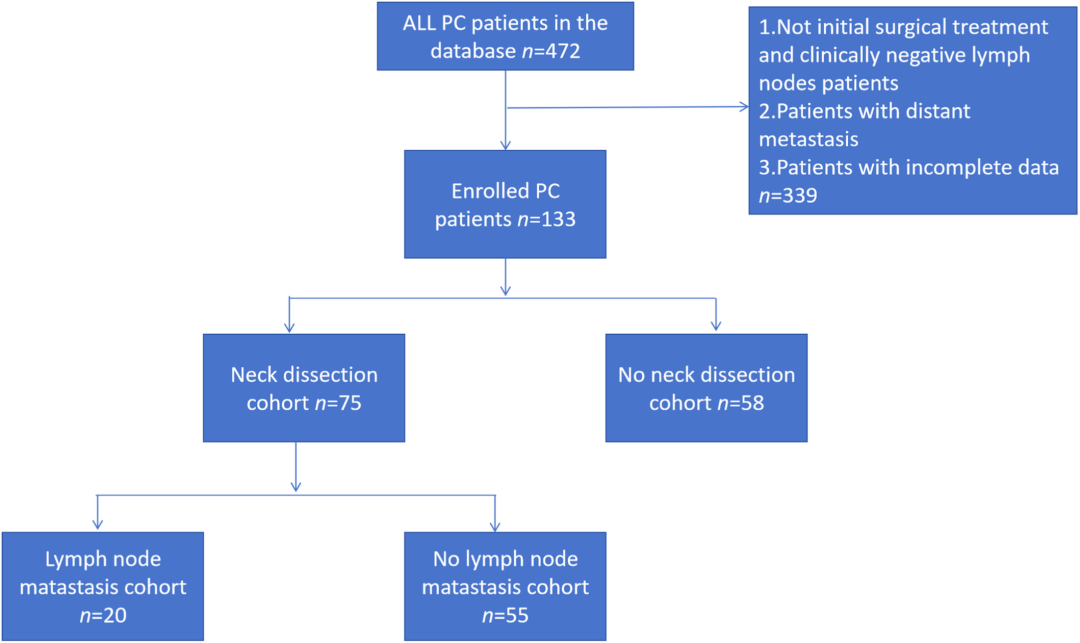
(点击图片即可免费阅读、下载全文)
Objective
This study aimed to explore the prognostic effect of neck dissection and to identify risk factors associated with occult lymph node metastasis (OLNM) in clinically node-negative (cN0) parotid carcinoma (PC).
Methods
A retrospective analysis was conducted on cN0 PC patients who underwent primary surgery at the National Cancer Center/Cancer Hospital, Chinese Academy of Medical Sciences, between 2012 and 2022. Kaplan–Meier (KM) survival analyses were carried out to evaluate differences in progression-free survival (PFS) and overall survival (OS) between patients undergoing neck dissection and those who did not. Clinical variables associated with OLNM in the neck dissection group were assessed using univariate and multivariate logistic regression analyses.
Results
Among 472 PC patients, 133 were classified as cN0 following initial surgery, of whom 75 (56.4%) underwent neck dissection. Pathological lymph node metastases were confirmed in 20 (26.7%) patients in the neck dissection cohort. Poor tumor differentiation was identified as an independent risk factor for OLNM (p = 0.017). No significant differences in PFS or OS were observed between the no-neck dissection and neck dissection groups for patients with low-grade or well-differentiated tumors (p > 0.05). However, neck dissection was associated with significantly prolonged PFS in patients with tumors of higher grade or low to moderate differentiation (p < 0.05). Notably, OS did not improve with neck dissection across all subgroups (p > 0.05).
Conclusion
Poorly differentiated tumors in cN0 PC are independently associated with a higher risk of OLNM. While prophylactic neck dissection may enhance PFS in patients with higher grade or poorly differentiated tumors, it does not confer a survival benefit in terms of OS. These findings support the selective use of neck dissection in patients with higher risk tumor profiles.
如何引用
Ning, Y., Song, Y., He, Y., Li, H. and Liu, S. (2025), Prognostic Effect of Neck Dissection and Risk Factors for Occult Lymph Node Metastasis in cN0 Parotid Carcinoma. Cancer Innovation, 4: e70007. https://doi.org/10.1002/cai2.70007
07
标题
Coexistent Pulmonary Tuberculosis and Lung Cancer: An Analysis of Incidence Trends, Financial Burdens and Influencing Factors
肺结核与肺癌共病的流行趋势、经济负担及影响因素研究
作者
Fei Qi, Hongjie Yang, Yi Han, Yujie Dong, Fan Zhang, Yishuo Wang, Juan Du, Yuan Gao, Xueguang Hu, Liqun Zhang, Tongmei Zhang*
图片摘要
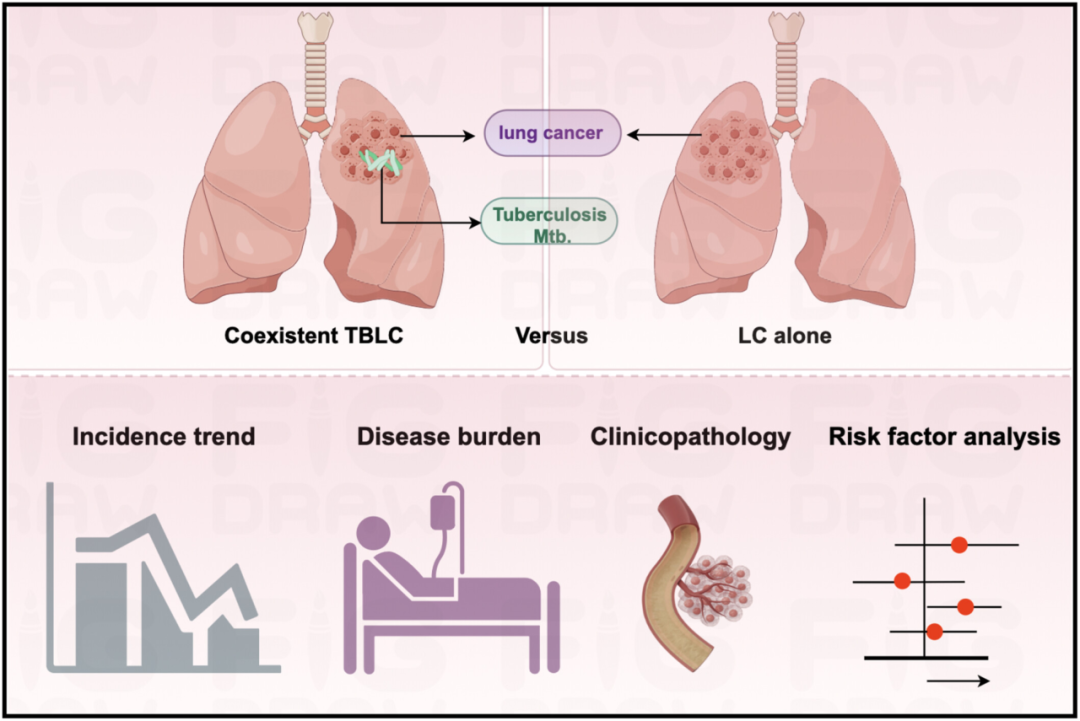
(点击图片即可免费阅读、下载全文)
Background
Tuberculosis (TB) and lung cancer (LC) are both major global health threats. However, coexistent pulmonary TB and LC (TBLC) is a unique condition for which incidence trends and risk factors have not been fully defined.
Methods
We retrospectively reviewed the medical records of patients with TBLC and LC alone between 2010 and 2022 at Beijing Chest Hospital, the standard authority for the diagnosis and treatment of TB and LC in China. The cumulative incidence rate (CIR) of TBLC was calculated as the number of new TBLC cases/number of LC cases at risk per 100,000 annually. The comparative incidence rate ratio (IRR) was estimated to be the TB incidence in LC patients/TB incidence in the general population. Logistic regression was used to explore risk factors for TBLC.
Results
The CIR of TBLC has rapidly increased each year since 2014 and reached 7027 per 100,000 LC patients in 2022. Patients with LC had a higher risk of developing active TB than the general population (IRR = 25.21, 95% confidence interval [CI]: 21.54–29.89). Medical expenditure per patient was 100.60 thousand yuan for those with TBLC and 105.60 thousand yuan for patients with LC (p = 0.687). Patients with TBLC were older (63.61 ± 10.46 vs. 61.08 ± 10.77, p < 0.001) and had a higher male-to-female ratio (2.82 vs. 1.59, p = 0.044) than those with LC alone. A tendency of earlier disease onset was observed in patients with LC rather than TBLC. A majority (44.92%) of TBLC lesions were located in the upper lobes of the lung and had a higher proportion of squamous cell carcinomas than LC alone (32.24% vs. 27.49%, p = 0.002). TBLC also presented more aggressively, with more lymph node involvement and distant metastases. Multivariate analysis revealed that older age, the male sex, mediastinal lymph node invasion, lung/bone metastases, anemia, hypoalbuminemia, malnutrition, pulmonary fibrosis, and chronic obstructive pulmonary disease were risk factors for active TBLC.
Conclusions
There has been a rise in the incidence of coexistent TBLC and a concomitant increase in its financial burden in China that deserves more awareness and attention.
如何引用
Qi, F., Yang, H., Han, Y., Dong, Y., Zhang, F., Wang, Y., Du, J., Gao, Y., Hu, X., Zhang, L. and Zhang, T. (2025), Coexistent Pulmonary Tuberculosis and Lung Cancer: An Analysis of Incidence Trends, Financial Burdens and Influencing Factors. Cancer Innovation, 4: e70009. https://doi.org/10.1002/cai2.70009
08
标题
SKIL Promotes Pancreatic Cancer Metastasis by Inhibiting TSPYL2 to Activate the TGF-β Pathway
SKIL通过抑制TSPYL2激活TGF-β 通路促进胰腺癌转移
作者
Chenxi Wang, Weiwei Song, Yixuan Zhang, Hongming Deng, Zixiang Zhou, Jing Zhu, Xiaobing Wang*
图片摘要
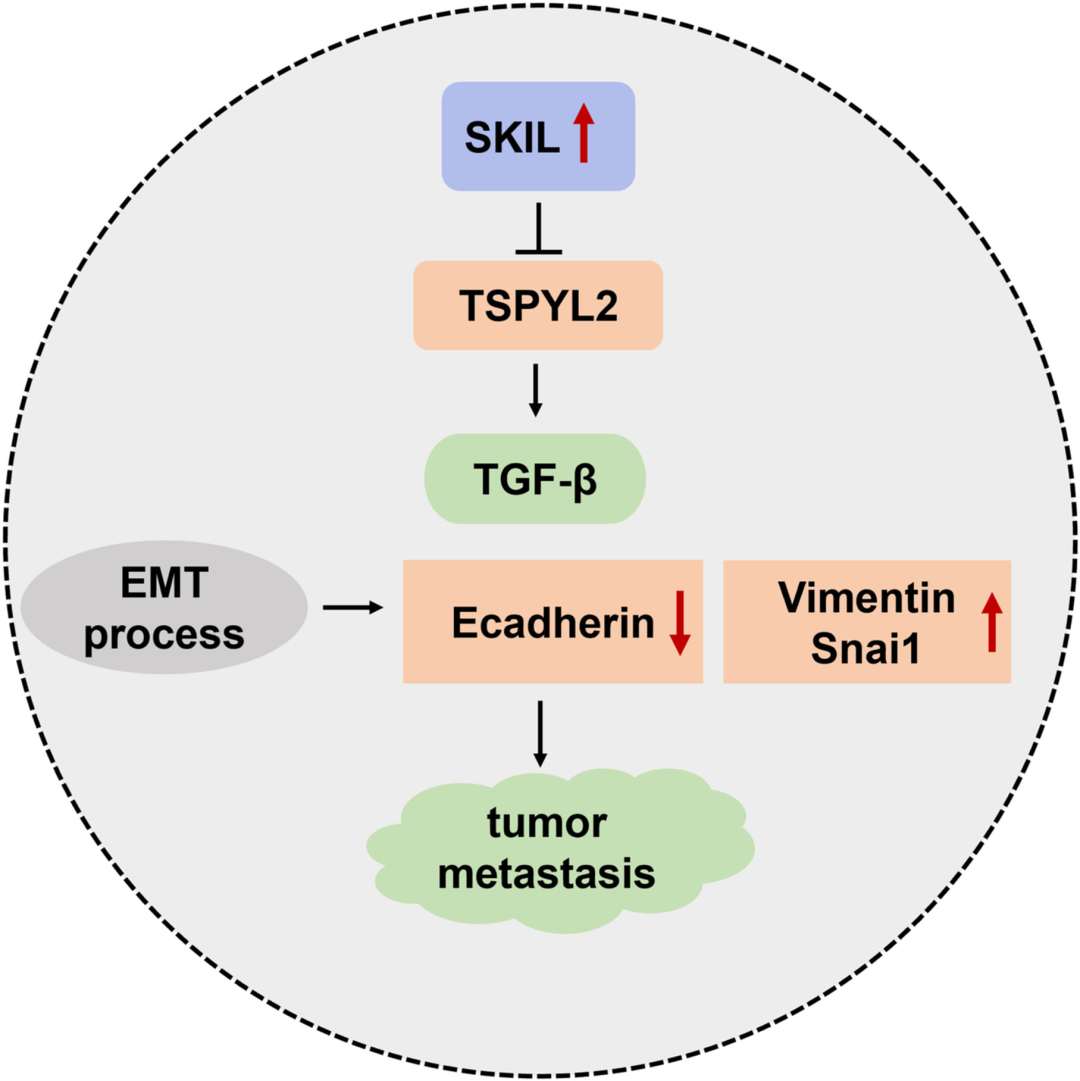
(点击图片即可免费阅读、下载全文)
Background
Pancreatic adenocarcinoma (PAAD) represents a highly fatal form of cancer. The 5-year survival rate for patients with this disease is only around 10%. A significant hurdle in its management is the absence of characteristic early-stage symptoms. As a result, a large majority of pancreatic cancer patients are diagnosed when the disease has reached an advanced stage or has metastasized. Consequently, taking measures to suppress the occurrence of metastasis in pancreatic cancer can bring about a substantial improvement in patients survival rates and overall prognosis. SKIL, known to promote cancer progression, is implicated in cell proliferation, epithelial–mesenchymal transition (EMT), and metastasis, but its specific function in pancreatic cancer remains unclear.
Methods
We investigated the effects of SKIL on the proliferation, apoptosis, and metastasis of pancreatic cancer cells. Through ChIP-seq, we identified the SKIL downstream target gene and further explored the mechanism by which SKIL regulates the metastasis of pancreatic cancer cells through functional experiments and Western blot.
Results
A high level of SKIL expression is associated with an unfavorable prognosis in PAAD; it promotes cell migration and EMT. Through ChIP-seq analysis, we identified that SKIL inhibits TSPYL2, a nuclear protein regulating the TGF-β pathway by binding to the TGFB1 promoter. Further studies carried out by us confirmed that SKIL modulates the TGF-β pathway via TSPYL2, facilitating EMT and metastasis in pancreatic cancer cells, independent of Smad4.
Conclusions
These findings reveal a novel regulatory mechanism involving SKIL, TSPYL2, and the TGF-β pathway, offering new therapeutic targets for PAAD.
如何引用
Wang, C., Song, W., Zhang, Y., Deng, H., Zhou, Z., Zhu, J. and Wang, X. (2025), SKIL Promotes Pancreatic Cancer Metastasis by Inhibiting TSPYL2 to Activate the TGF-β Pathway. Cancer Innovation, 4: e70011. https://doi.org/10.1002/cai2.70011
了解医学 守护健康
欢迎点击下方公众号
更多医学相关内容为您呈现
✦
•
✦

威立(Wiley)是全球领先的出版机构之一。作为科研和学习领域值得信赖的领导者,我们凭借行业前沿的内容、服务、平台与知识网络,精准对接和满足科研人员、学生、教师、专业人士、机构和企业客户不断变化的需求。威立致力于帮助求知者将当今严峻的挑战转化为未来璀璨的机遇,践行两个多世纪以来不变的使命——激发人类潜能。

This article is fromWiley威立Please contact the webmaster for deletion if there is any infringement.







